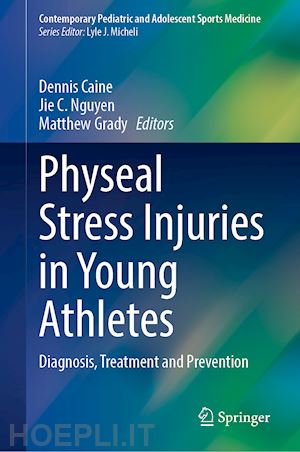
Questo prodotto usufruisce delle SPEDIZIONI GRATIS
selezionando l'opzione Corriere Veloce in fase di ordine.
Pagabile anche con Carta della cultura giovani e del merito, 18App Bonus Cultura e Carta del Docente
Participation in youth sports is increasingly popular and has important and wide-ranging health benefits. However, year-round involvement in youth sport involves high levels of repetitive movement which may foster an environment where overuse injuries are likely to occur. Of particular concern are physeal stress injuries (PSIs) which are unique to skeletally immature athletes and are becoming common in youth sports. These injuries may be associated with a substantial injury burden, especially at advanced levels of training and competition. In extreme cases, PSIs can progress to produce skeletal growth disturbance, which may necessitate surgical intervention and correction. This book summarizes the status of our knowledge on the occurrence, underlying pathophysiologic mechanisms, diagnosis, treatment, and prevention of PSIs affecting children and adolescents involved in various sports.
Physeal Stress Injuries in Young Athletes: Diagnosis, Treatment and Prevention is organized into three parts. Part I, Introduction opens with a chapter that provides a foundation and basic framework on bone growth for readers to better understand and anticipate potential complications and growth disturbance that can arise from PSIs. This is followed by two chapters that provide an overview of the two anatomically distinct types of PSIs – epiphyseal and apophyseal PSIs. In addition to providing an overview of the occurrence and distribution of these injuries, these two chapters also provide a novel framework for understanding the underlying pathophysiologic mechanisms of PSIs.
Part II, Diagnosis and Treatment consists of 8 chapters covering common sites of epiphyseal and apophyseal PSIs, anatomically divided into those occurring at the shoulder, elbow, wrist, hand and fingers, spine, pelvis and hip, knee, ankle and foot. Each chapter follows a similar outline and provides details on location-specific patterns of PSIs, available demographic and epidemiologic data, known or postulated injury mechanisms, underlying pathophysiologic mechanisms, typical clinical presentation, key diagnostic imaging findings, management, and factors that impact prognosis and outcome.
Part III, Prevention consists of a chapter that begins with a discussion on risk factors common to epiphyseal and apophyseal PSIs. This is followed by a review of practical preventive measures that are generally applicable to patients diagnosed with PSI. Finally, the last section of this chapter reviews strategies designed to target prevention of specific PSIs at various anatomical locations.
Primary care sports medicine physicians, urgent and emergency care physicians, orthopedic surgeons, physical and athletic therapists, and athletic trainers who provide care for pediatric athletes will find this book helpful in identifying and treating young athletes with physeal stress injuries, identifying knowledge gaps, and implementing appropriate preventive measures that can reduce future incidence and severity of these injuries. Sport governing bodies and coaches can also use the information gathered within this book to guide the development and optimization of injury prevention programs and to reduce underdiagnosis and undertreatment of physeal stress injuries.
The Growing Skeleton.- Epiphyseal PSIs: An Overview.- Apophyseal PSIs An Overview.- Physeal Stress Injuries of the shoulder.- Physeal stress injuries of the elbow.- Physeal Stress Injuries of the wrist.- Physeal Stress Injuries of the hand/fingers.- Physeal Stress Injuries of the spine.- Physeal Stress Injuries of the hip and pelvis.- Physeal Stress Injuries of the knee.- Physeal Stress Injuries of the Ankle/Foot.- Prevention of Physeal Stress Injuries.
Prof. Dennis Caine, Ph.D.
Dept. of Education, Health and Behavior Studies
University of North Dakota
Grand Forks, ND, USA
Dr. Jie C. Nguyen
Department of Radiology
Children’s Hospital of Philadelphia
Philadelphia, PA, USA
Dr. Matthew Grady
Division of Orthopedic Surgery
Children’s Hospital of Philadelphia
Philadelphia, PA, USA











Il sito utilizza cookie ed altri strumenti di tracciamento che raccolgono informazioni dal dispositivo dell’utente. Oltre ai cookie tecnici ed analitici aggregati, strettamente necessari per il funzionamento di questo sito web, previo consenso dell’utente possono essere installati cookie di profilazione e marketing e cookie dei social media. Cliccando su “Accetto tutti i cookie” saranno attivate tutte le categorie di cookie. Per accettare solo deterninate categorie di cookie, cliccare invece su “Impostazioni cookie”. Chiudendo il banner o continuando a navigare saranno installati solo cookie tecnici. Per maggiori dettagli, consultare la Cookie Policy.